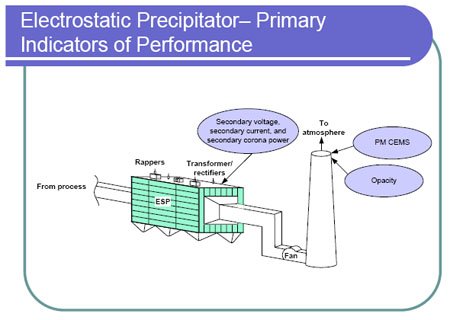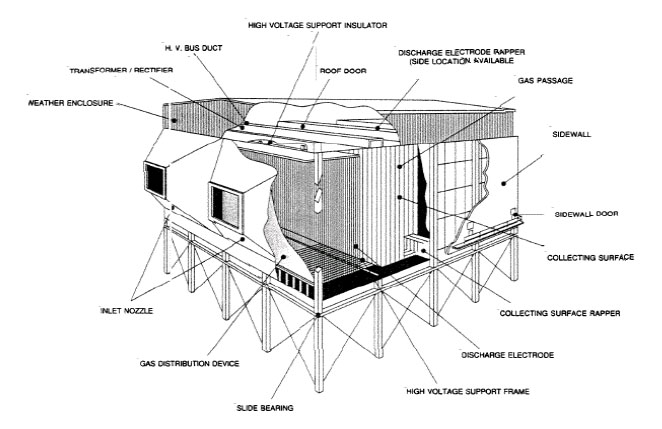Monitoring by Control Technique - Electrostatic Precipitators
Description
An electrostatic precipitator (ESP) removes particles from a gas stream by using electrical energy to charge particles either positively or negatively. The charged particles are then attracted to collector plates carrying the opposite charge. The collected particles may be removed from the collector plates as dry material (dry ESPs), or they may be washed from the plates with water (wet ESPs). ESPs are capable of collection efficiencies greater than 99 percent.
An ESP is primarily made up of the following four components: gas distribution plates, discharge electrodes, collection surfaces (either plates or pipes) and rappers. The gas distribution plates consist of several perforated plates which help maintain proper flow distribution of the entering gas stream. The discharge electrodes are divided into fields. Most ESPs have three or four fields in series; however, very large units may have as many as fourteen fields in series. Discharge electrodes are energized by a single transformer-rectifier (T-R) set power supply. The energized electrodes create ions that collide with the particles and apply the electrical charge to the particles contained in the incoming gas stream. The collection plates or pipes provide the collection surfaces for the charged particulate matter. The rapping system is responsible for removing the collected particulate matter from the collection surfaces.
ESPs are generally classified as dry ESPs (the most commonly used) and wet ESPs. The primary difference between the two classifications is the method by which the collector plates are cleaned. In dry ESPs, the collector plates are cleaned by applying mechanical impulses or vibration to the plates, which knocks loose the collected particulate matter (referred to as rapping). In wet ESPs, the collector plates are cleaned by rinsing with water. Wet ESPs are typically employed when gas streams contain sticky particles with low resistivity.
ESP performance can be affected by particle resistivity. Particle resistivity is the property that influences the deposition and removal of particles from the collection plates. The desirable situation is to have particles that conduct away some of their charge once they reach the plate, so that the deposition of other particles is not inhibited, but retain enough of their charge to lightly hold them to the plate. The characteristic is termed moderate resistivity. If the particles have very high resistivity, they are slow to conduct away their charge, causing a negative charge to build up on the plates that inhibit other particles from depositing. If the particles have very low resistivity, they rapidly lose their charge when reaching the plate and pick up the charge of the plate, causing them to be repelled back into the gas stream where they are recharged negatively.
For more information, see the box More About Electrostatic Precipitators.
Monitoring Information
The primary indicators of the performance of ESPs are the particulate matter outlet concentration, which can be measured with a particulate matter continuous emissions monitoring system (CEMS), opacity, secondary corona power, secondary voltage (voltage across the electrodes), and secondary current (current to the electrodes). Other indicators of performance are the spark rate, primary current, primary voltage, inlet gas temperature, gas flow rate, rapper operation, and number of fields in operation.
The Compliance Assurance Monitoring (CAM) Technical Guidance Document (TGD) is a source of information on monitoring approaches for different types of control devices. Specific information provided in the CAM TGD related to ESPs include example CAM submittals based on case studies of actual facilities.
For more information, see the box Monitoring and the CAM Rule.
Costs
Costs of electrostatic precipitators are discussed in the EPA Air Pollution Control Cost Manual*, Section 6 Particulate Matter Controls Chapter 3 ESP (pdf) (586.83 KB) . Costs of monitoring systems, both Continuous Emission Monitors and parametric monitoring systems, are addressed in the EPA Air Pollution Control Cost Manual*, Chapter 4 Monitors (pdf) (125.16 KB) .
Specific tools have been developed to estimate ESP costs when used to control particulate matter from coal-fired power plants and coal-fired utility boilers.
As indicated above in the monitoring section, indicators of ESP performance include the particulate matter outlet concentration, which can be measured with a particulate matter CEMS. Costs associated with purchasing and installing a CEMS can be estimated using the EPA CEMS Cost Model Version 3.0.
For more information, see the box More About Electrostatic Precipitators and Costs
(Courtesy of the Institute of Clean Air Companies)
- Air Pollution Control Cost Manual*, Section 6 Particulate Matter Controls Chapter 3 ESP (pdf) (586.83 KB) (70 pp, 586 KB).
- EPA Fact Sheet - Dry Electrostatic Precipitator (ESP), Wire-Pipe Type, EPA-452/F-03-027 (pdf) (5 pp, 60 KB)
- EPA Fact Sheet - Dry Electrostatic Precipitator (ESP) - Wire-Plate Type, EPA-452/F-03-028 (pdf) (6 pp, 34 KB)
- EPA Fact Sheet - Wet Electrostatic Precipitator (ESP) - Wire-Pipe Type, EPA-452/F-03-029 (pdf) (4 pp, 37 KB)
- EPA Fact Sheet - Wet Electrostatic Precipitator (ESP) - Wire-Plate Type, EPA-452/F-03-030 (pdf) (6 pp, 37 KB)
- Training Video - Air Pollution Control Devices - Electrostatic Precipitators (MP4) (zip)

- CAM Rule (pdf) (48 pp, 408 KB) - Federal Register - October 22, 1997
- Current Knowledge of Particulate Matter (PM) Continuous Emission Monitoring, EPA-454/R-00-039 (pdf) (87 pp, 3.7 MB)
- Evaluation of Particulate Matter Continuous Emission Monitoring Systems, Volume 1 Technical Report, EPA-454/R-00-040a (pdf) (154 pp, 4.5 MB)
- CAM TGD Appendix A: Electrostatic Precipitators
- CAM TGD Appendix A: Wet Electrostatic Precipitators

